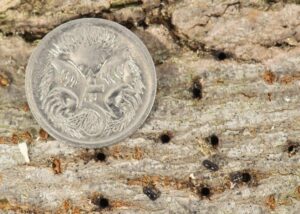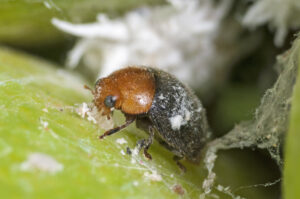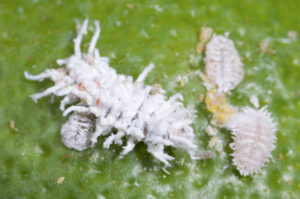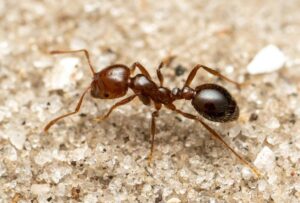How invasive insect pests spread
By Denis Crawford
Several invasive insects currently of concern to the horticultural industry have something in common – the ability to travel long distances in horticultural material.
If reading a newspaper recently might make you think that we are under threat from invasive insects from all points of the compass, you would be right. Recent articles have covered the imported red fire ant in south-east Queensland and northern New South Wales, the polyphagous shothole borer in Western Australia, the tomato potato psyllid also in Western Australia, and the papaya mealybug in the Northern Territory.
The insect receiving the most media attention is the red imported fire ant (Solenopsis invicta). This ant is native to the tropical areas of Central South America and was first detected in Australia in Brisbane in 2001. Fire ants defend their domed nests aggressively by swarming towards an intruder and stinging them. They are a significant public health problem because reactions to their sting range from localised swelling to anaphylactic shock. Fire ants are omnivorous insects that have the potential to destroy crops and devastate natural ecosystems by competing with and/or feeding on other insects and invertebrates.
An eradication program has been underway in south-east Queensland since 2001. Initially the results were positive. I remember speaking to someone involved with the eradication program a few years after it started, and they said that the fire ant was more than 90% under control. Unfortunately, the picture is very different today. The ant has spread from a relatively small area of Brisbane out to an area of about 900,000 hectares, and it has also been detected in northeastern NSW. The NSW detections are thought to be isolated outbreaks most likely spread via infested topsoil moved from south-east Queensland.

Funding has been an ongoing issue with the eradication program. A 2019 review of the program noted a number of serious declines in funding; for example expenditure in 2008-09 was only 29% of expenditure recorded in 2003-04. Several attempts have been made to adequately fund the program since then. In a 2017 Pest Files I wrote that funding had increased to $38 million per year for 10 years and that authorities were still confident of eradicating the fire ant.
Fast forward a few years and we learn that about $740 million has been spent trying to eradicate the fire ant so far. Some additional funding has been announced recently but according to the Invasive Species Council that is still woefully short, “The most recent independent review found fire ant eradication would cost up to $300 million per year over 10 years – significantly more than the current level of commitment”.
Regardless of which eye watering amount of money is the appropriate amount, we need to look at how this ant spreads. Winged ants can fly about 5km, but that only happens at certain times of the year when nests release mating swarms. The ants can be spread much further with the movement of materials such as soil, hay, mulch, manure, quarry products, turf and potted plants. Some areas of south-east Queensland have been declared biosecurity zones with regulations governing movement of material such as soil and potted plants within and out of the declared areas.

Polyphagous shot-hole borer (Euwallacea fornicatus) is a beetle native to South-East Asia that has spread to several other countries including South Africa, Israel, USA (California) and recently, Australia. Currently the borer is only found in parts of Perth in Western Australia where it was first detected in August 2021. Host plants include box elder maple (Acer negundo), maple (Acer), oak (Quercus), plane (Platanus), coral (Erythrina), avocado (Persea), locust (Robinia), fig (Ficus) and poplars (Populus). This pest was extensively covered in Nursery Papers of October 2022.
Polyphagous shot-hole borer has a symbiotic relationship with a Fusarium fungus species which the beetles cultivate inside trees. Infection with Fusarium can result in dieback and possible plant death, depending on the plant species. The fungus is the problem, the beetles on their own would have little effect on a large tree.
Adult female borer beetles usually only fly short distances (less than 50m) but the beetles may move long distances with the movement of firewood, mulch and plants. To prevent this, authorities in Western Australia have declared a 600 km2 quarantine area in parts of Perth. The Department of Primary Industries and Regional Development (DPIRD) have installed monitoring traps throughout the area. DPIRD are also inspecting trees with suspected borer infestations and giving notice if a tree needs to be removed. There are no effective chemical treatments. If everyone adheres to the rules of the quarantine area, the authorities have a good chance of eradicating this pest.
Tomato potato psyllid (Bactericera cockerelli) is an invasive sap-sucking insect native to North and Central America. It has spread to other parts of the world including New Zealand and Norfolk Island. In 2017 it was detected in parts of southwestern Western Australia, but not in the eastern states. It feeds on tomato, potato, capsicum, chilli, goji berry, tamarillo, eggplant and sweet potato.

As well as causing damage to plants directly while feeding, the tomato potato psyllid can spread the bacterial plant pathogen Candidatus Liberibacter solanacearum. The pathogen causes the disease known as ‘Zebra chip’ in potatoes, rendering any infected produce unsellable. Fortunately, the pathogen has not been detected in Australia yet, but the fear is that it will arrive in Australia at some point. The Department of Primary Industries and Regional Development (DPIRD) recently declared that the tomato potato psyllid could not be eradicated in Western Australia, so the focus is now on managing the pest. DPIRD provides a list of chemicals approved for use in home gardens.
Tomato potato psyllid can spread through the movement of plants and plant materials (fruit, vegetables and nursery stock) on horticultural machinery and equipment. The adults have wings and can fly and may be transported long distances by wind. The juveniles don’t have wings and can only be transported on infested plant material. A quarantine area has been declared including the Perth metropolitan area, and much of the southwest and western coastal areas of Western Australia. Tomato potato psyllid is less likely to spread outside those areas if everyone adheres to the conditions of the quarantine and controls the psyllid if they find it in their garden.
Papaya mealybug (Paracoccus marginatus) is a sap-sucking pest native to Central America. It has spread around the world in live plant material and has recently (July 2023) been found in the Greater Darwin area of the Northern Territory. The mealybug’s host plants include papaya, frangipani and hibiscus.

Heavy infestations of papaya mealybug can cause leaf distortion, fruit and flower drop, and sooty mould that grows on the honeydew secreted by the mealybugs. Papaya mealybug is a considerable threat to commercial papaya plantations. The mealybug is currently confined to the suburbs, so the NT Government is assisting gardeners by releasing the mealybug ladybird (Cryptolaemus montrouzieri) – colloquially known as the ‘mealybug destroyer’. The trial has only just begun – I’ll let you know what happens.
The common thread here is pretty obvious, these invasive insects don’t travel great distances on their own. The two invasive insects currently confined to Western Australia, the polyphagous shot-hole borer and the tomato potato psyllid should never make it to the eastern states. Vice versa, the imported red fire ant should never spread to the west (just for completion, there was an incursion at the port of Fremantle but that didn’t come from the south-east Queensland area).
All of the insects mentioned here are from other countries and have arrived in Australia in cargo most likely of the agricultural or horticultural variety, despite the best efforts of the relevant authorities. Now it’s up to the people in the relevant quarantine or biosecurity areas to stop the spread within Australia.

